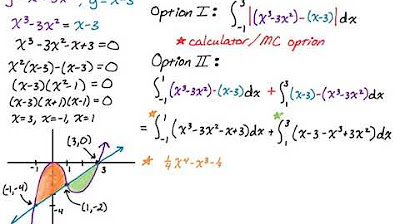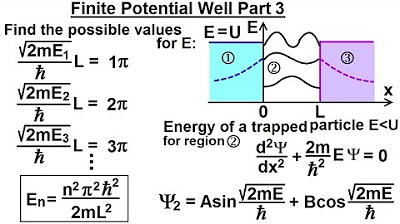Type II regions in three dimensions | Divergence theorem | Multivariable Calculus | Khan Academy
TLDRThe script discusses Type 2 regions in three-dimensional space, contrasting them with Type 1 regions. It explains that Type 2 regions are defined by x varying between two functions of y and z, with the domain D2 in the yz plane. Examples include spheres and cylinders, which can be both Type 1 and Type 2 regions, depending on orientation. The script also explores why certain shapes, like an hourglass, cannot be Type 2 regions due to the complexity of x values for a given yz pair, emphasizing the importance of orientation and function bounds in defining these regions.
Takeaways
- 📚 The script discusses the concept of Type 2 regions in three-dimensional space, emphasizing the importance of orientation in their definition.
- 📐 Type 2 regions, denoted as R2, are defined by a domain D2 in the yz-plane and functions g1(yz) and g2(yz) that bound x from below and above, respectively.
- 🔄 The orientation for Type 2 regions is different from Type 1 regions, where x varies between two functions of y and z instead of z varying between functions of x and y.
- 🌐 The script uses the example of a sphere to illustrate that it can be both a Type 1 and a Type 2 region, depending on how it is oriented in the coordinate system.
- 🛰️ The sphere's domain in the yz-plane is defined, and the bounds for x are described, showing how the entire sphere can be filled for every yz point in the domain.
- 🔄 The script also revisits the cylinder example, demonstrating that it can be considered a Type 2 region by orienting its domain in the yz-plane and defining appropriate bounds for x.
- 🚫 The 'hourglass' shape, when oriented in a certain way, cannot be a Type 1 region, but when reoriented with the domain in the yz-plane and appropriate bounds for x, it can be a Type 2 region.
- 🔄 The script highlights the flexibility in classifying geometric shapes as Type 1, Type 2, or both, based on how the domain and bounds are defined.
- 🚫 An alternative orientation of the hourglass shape is presented, showing that it cannot be a Type 2 region because it does not have a simple lower and upper bound function for x in relation to y and z.
- 📐 The importance of the domain's orientation and the selection of appropriate bounding functions for x are emphasized to determine whether a shape can be classified as a Type 2 region.
- 🤔 The script encourages critical thinking about the properties of three-dimensional shapes and their representation in mathematical terms, highlighting the complexity of spatial reasoning.
Q & A
What is a Type 2 region in the context of the script?
-A Type 2 region, denoted as R2, is a set of points in three dimensions where x varies between two functions of y and z, g1(yz) and g2(yz), with yz pairs belonging to a domain D2.
How does the orientation of a region affect its classification as a Type 1 or Type 2 region?
-The orientation of a region affects its classification because the way the region is positioned in the coordinate system determines whether it can be defined by a single upper and lower bound function of one variable with respect to the other two (as in Type 1 and Type 2 regions).
What is the domain D2 mentioned in the script?
-The domain D2 is the set of all possible yz pairs that define the lower and upper bounds for x in a Type 2 region.
Can a sphere be considered both a Type 1 and a Type 2 region?
-Yes, a sphere can be considered both a Type 1 and a Type 2 region because it can be defined by upper and lower bounds of either x with respect to y and z or z with respect to x and y.
How is the orientation of the cylinder in the script different from the sphere to be considered a Type 2 region?
-The cylinder is oriented such that its domain is a rectangle in the yz plane, with the back and front sides of the cylinder representing the lower and upper bounds for x, respectively.
What is the significance of the 'dumbbell' shape in the script when discussing Type 1 and Type 2 regions?
-The 'dumbbell' shape is used as an example to illustrate that certain shapes cannot be classified as Type 1 or Type 2 regions when oriented in a specific way, as they do not have a simple upper and lower bound function for one variable with respect to the other two.
Why is the 'hourglass' shape not considered a Type 2 region when oriented with the top facing us?
-The 'hourglass' shape, when oriented with the top facing us, is not a Type 2 region because for any given yz pair, there can be multiple x values associated with different points on the hourglass, which violates the definition of a Type 2 region.
What is the relationship between the functions g1 and g2 in defining a Type 2 region?
-In a Type 2 region, g1 and g2 are functions of y and z that serve as the lower and upper bounds for x, respectively. The value of x must be greater than or equal to g1(yz) and less than or equal to g2(yz).
How does the script suggest visualizing the bounds of a Type 2 region?
-The script suggests visualizing the bounds of a Type 2 region by considering the domain in the yz plane and then drawing the lower and upper bounds as surfaces in three-dimensional space that x can take values between.
What is the role of the yz plane in defining a Type 2 region?
-The yz plane is where the domain D2 is defined for a Type 2 region. It is the plane in which the pairs of y and z values are considered to establish the bounds for x.
Outlines
📐 Understanding Type 2 Regions in 3D Space
This paragraph delves into the concept of Type 2 regions in three-dimensional space. It introduces the idea of defining regions in terms of yz-coordinates rather than the traditional xy-coordinates. The Type 2 region, denoted as R2, is characterized by x being bounded by two functions of y and z, g1(yz) and g2(yz). The paragraph provides examples of shapes such as a sphere and a cylinder, explaining how they can be considered both Type 1 and Type 2 regions due to their orientation. The speaker attempts to visualize these regions by considering the yz plane as the domain and discussing how x varies between the two bounding functions. The paragraph concludes by questioning the possibility of the dumbbell shape, previously identified as not a Type 1 region, being a Type 2 region.
🔄 Exploring the Versatility of Shapes as Type 2 Regions
The second paragraph continues the exploration of Type 2 regions, focusing on the potential for different shapes to fit this classification. It begins by considering the domain in the yz plane and how it might be used to define the lower and upper bounds of x for a Type 2 region. The speaker uses the example of an hourglass shape, demonstrating that when oriented in a certain way, it can indeed be a Type 2 region, with g1 representing the backside and g2 the front side of the hourglass. However, when the orientation is changed, the hourglass no longer fits the criteria for a Type 2 region, as it would require multiple x values for a single yz pair. The paragraph illustrates the importance of orientation and the constraints of the Type 2 region definition, concluding with the assertion that while the hourglass can be a Type 1 region, it cannot be a Type 2 region in the alternate orientation presented.
Mindmap
Keywords
💡Type 2 regions
💡Orientation
💡yz-coordinates
💡Domain
💡Function g1 of yz
💡Function g2 of yz
💡Sphere
💡Cylinder
💡Dumbbell
💡Hourglass
Highlights
Introduction to Type 2 regions and their orientation in 3D space.
Definition of Type 2 region R2 in terms of yz coordinates and bounded x values.
Comparison of Type 2 regions to Type 1 regions, emphasizing the difference in variable orientation.
Exploration of shapes as Type 2 regions, including a sphere and cylinder.
Explanation of how a sphere can be both a Type 1 and Type 2 region.
Demonstration of constructing a sphere in the yz plane as a Type 2 region.
Description of the lower and upper bounds on x for the sphere in the yz plane.
Analysis of the cylinder as a Type 2 region with bounds in the yz plane.
Illustration of the back and front sides of the cylinder as g1 and g2 functions.
Discussion of the hourglass shape and its potential as a Type 2 region.
Explanation of why the original hourglass orientation is not a Type 1 region.
Attempt to reorient the hourglass to fit the criteria of a Type 2 region.
Identification of the reoriented hourglass as a valid Type 2 region.
Contrasting the rotated hourglass, which does not meet the criteria for a Type 2 region.
Explanation of why the rotated hourglass has multiple x points for a given yz, disqualifying it as a Type 2 region.
Conclusion that the rotated hourglass can be a Type 1 region but not a Type 2 region.
Transcripts
Browse More Related Video

Type III regions in three dimensions | Divergence theorem | Multivariable Calculus | Khan Academy

Type I regions in three dimensions | Divergence theorem | Multivariable Calculus | Khan Academy

Divergence theorem proof (part 5) | Divergence theorem | Multivariable Calculus | Khan Academy

Area Between Two Curves with Multiple Regions: y = x^3-3x^2 and y = x-3

AP Calculus Exam Tip: Definite Integral of Absolute Value Function

Physics - Ch 66 Ch 4 Quantum Mechanics: Schrodinger Eqn (34 of 92) Finite Potential Well Part 3
5.0 / 5 (0 votes)
Thanks for rating: